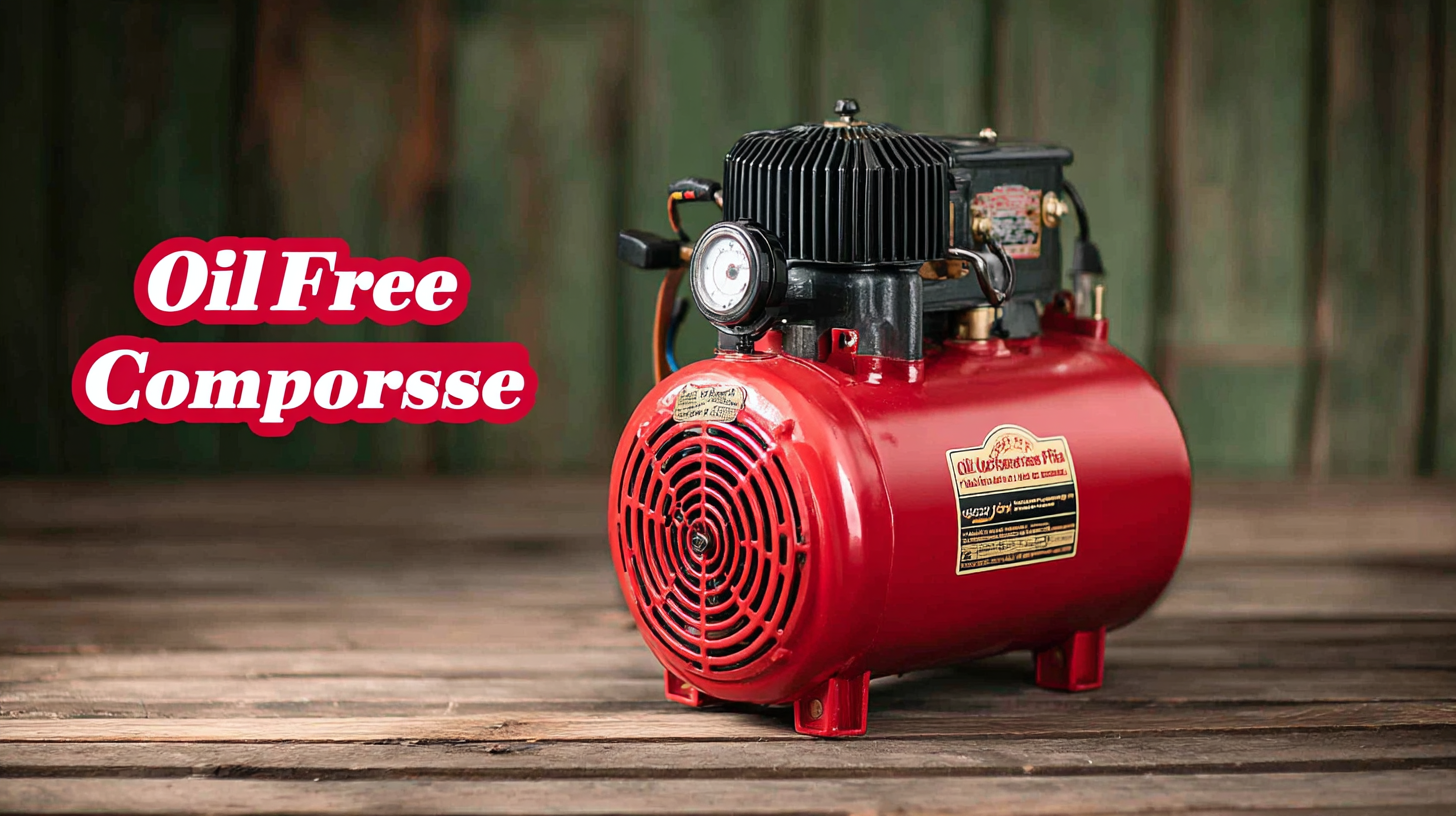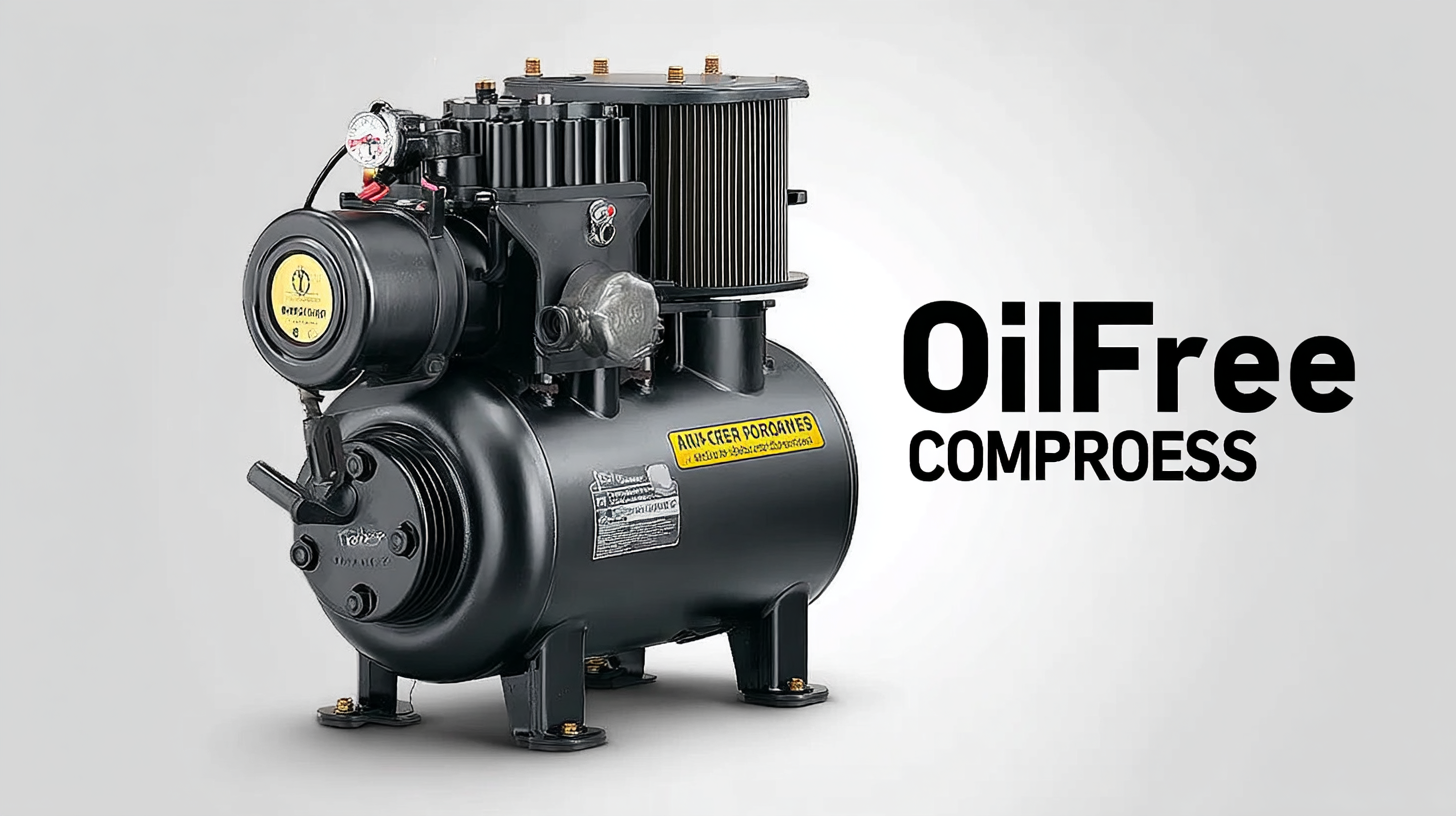
Best Oil-free Air Compressor Trends for 2025 and How to Choose the Perfect Model
As industries evolve, the demand for efficient, reliable, and environmentally-friendly tools has led to significant advancements in the air compressor market, particularly with Oil-free Air Compressors. According to a recent report by ResearchAndMarkets, the global oil-free air compressor market is projected to grow at a CAGR of 5.6% from 2020 to 2025, driven by increasing applications in sectors such as food and beverage, pharmaceuticals, and electronics. Selecting the ideal Oil-free Air Compressor requires careful consideration of various factors, including compressor type, required pressure levels, and energy efficiency. With the rise of sustainable practices and stricter regulations on oil emissions, understanding the latest trends and technologies in oil-free air compressors is crucial for industry professionals looking to invest in the right equipment for their operational needs. In this blog, we will provide a comprehensive checklist to help you choose the perfect model that aligns with both your business goals and sustainability objectives.

Top Features to Look for in Oil-Free Air Compressors for 2025
As the demand for efficient and eco-friendly air solutions continues to grow, oil-free air compressors are expected to dominate the market in 2025. According to a recent report by Research and Markets, the global oil-free air compressor market is projected to reach approximately $8 billion by 2025, driven by the increasing need for clean air in industries such as automotive, pharmaceuticals, and food processing. When selecting an oil-free air compressor model, considering specific features is crucial to optimizing performance and ensuring reliability.

One of the top features to look for is energy efficiency. Models equipped with variable speed drives (VSD) can lead to significant energy savings, with potential reductions in power consumption by up to 35%. Additionally, advancements in noise reduction technology have made modern oil-free compressors quieter than ever, with sound levels as low as 60 dB, making them suitable for indoor work environments. Furthermore, durability and maintenance requirements should also be factored in; models with built-in monitoring systems can alert users to potential issues before they escalate, ensuring minimal downtime and reduced service costs.
Comparing Performance: Oil-Free vs Oil-Lubricated Air Compressors
When it comes to air compressors, one of the most pivotal decisions buyers face is choosing between oil-free and oil-lubricated models. Oil-free air compressors, known for their portability and low maintenance, often find favor in environments where cleanliness is paramount, such as in dental practices or food processing facilities. According to a report by Research And Markets, the global oil-free air compressor market is forecasted to grow at a CAGR of 5.3% from 2021 to 2026, reflecting a burgeoning preference for oil-free solutions.
In contrast, oil-lubricated compressors are prized for their durability and longevity, making them ideal for industrial applications with heavy-duty demands. Data from Transparency Market Research indicates that these units typically outperform oil-free models in terms of continuous use and can handle higher workloads owing to their robust design. However, they do require more regular maintenance and oil changes, which can contribute to higher operational costs.
**Tips:** When selecting an air compressor, consider the intended application; oil-free models are best for light-duty, intermittent use, while oil-lubricated ones excel in heavy-duty, continuous applications. Always check for the noise level ratings, especially if the compressor will be used in indoor settings, to ensure a comfortable working environment. Lastly, consider energy efficiency ratings; some modern oil-free models can significantly reduce energy consumption, aligning with sustainability goals.
Comparison of Oil-Free vs Oil-Lubricated Air Compressors (2025 Trends)
Understanding Noise Levels: What to Expect from Oil-Free Models
When it comes to choosing an oil-free air compressor, noise levels are a critical factor that often influences purchasing decisions. Oil-free models are designed to operate without lubrication, which tends to result in quieter performance compared to their oil-lubricated counterparts. As we look towards 2025, advancements in technology are yielding compressors that not only maintain efficiency but also prioritize low decibel ratings. Users can typically expect noise levels in the range of 60 to 75 decibels, which is comparable to the sound of normal conversation, making these models particularly appealing for indoor use.
Understanding the implications of noise levels is essential for selecting the right oil-free air compressor. For individuals working in home workshops or residential areas, minimizing noise pollution is a priority. Fortunately, manufacturers are increasingly focusing on sound-dampening features, which help to mitigate operational noise. Furthermore, potential buyers should consider how different applications may require varying levels of tolerance for noise. Whether for hobby projects, light industrial tasks, or professional-grade work, knowing what to expect from oil-free models can lead to a more informed and satisfying purchase decision.
Energy Efficiency Trends in Oil-Free Air Compressors for 2025
As industries evolve, the demand for energy-efficient equipment continues to rise, particularly for air compressors. For 2025, oil-free air compressors are poised to lead the charge in energy efficiency, largely driven by advances in technology and growing environmental awareness. According to a recent report by Phoenix Energy, oil-free compressors can achieve energy savings of up to 25% compared to traditional options. This not only reduces operational costs but also minimizes the carbon footprint, aligning with global sustainability goals.
The shift toward energy-efficient designs is evident in new models featuring variable speed drives (VSDs), which dynamically adjust motor speed to match air demand. A study by the Compressor Efficiency Initiative found that compressors with VSD reduce energy consumption significantly during partial-load conditions, which are common in industrial settings. Furthermore, innovations in heat recovery systems have enabled users to reclaim up to 90% of the energy consumed, further enhancing overall efficiency. As manufacturers focus on these trends, selecting the right oil-free air compressor will be essential for organizations aiming for both economic and environmental benefits in 2025.
Best Oil-free Air Compressor Trends for 2025 and How to Choose the Perfect Model - Energy Efficiency Trends in Oil-Free Air Compressors for 2025
| Model Type | Max Pressure (psi) | Airflow (CFM) | Energy Efficiency Rating (EER) | Noise Level (dB) | Weight (lbs) |
|---|---|---|---|---|---|
| Model A | 125 | 4.5 | 9.0 | 70 | 40 |
| Model B | 150 | 5.0 | 8.5 | 65 | 45 |
| Model C | 100 | 3.5 | 9.5 | 72 | 35 |
| Model D | 120 | 4.0 | 8.0 | 68 | 50 |
Budgeting for Quality: Cost Comparisons of Leading Oil-Free Brands
When considering an oil-free air compressor, budgeting for quality is essential. Many leading brands offer a range of models, each with different price points, making it crucial to understand what you're paying for. Typically, entry-level models may start around $100, but investing in a more robust and durable compressor can range from $300 to $700 or more. This investment can drastically affect performance, efficiency, and lifespan, which are vital for both personal and professional use.

In terms of cost comparisons, it's important to examine features like noise levels, PSI ratings, and tank capacities. While a cheaper model might seem appealing, hidden costs such as maintenance and energy consumption can add up over time. For instance, brands like California Air Tools, DeWalt, and Makita are often praised for their reliability and efficiency, justifying their higher initial price with superior performance and durability. Choosing the right model involves not just looking at the upfront cost but also considering long-term value, ensuring your investment pays off in quality and functionality.
